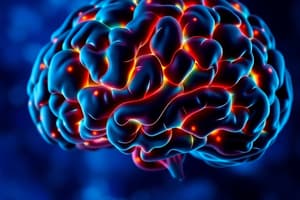Podcast
Questions and Answers
What connects the axon to the cell body of a neuron?
What connects the axon to the cell body of a neuron?
- Synapse
- Receptor
- Axon hillock (correct)
- Dendrite
What is the primary function of receptors in the nervous system?
What is the primary function of receptors in the nervous system?
- To generate action potentials directly
- To transform electrical energy into environmental energy
- To receive and convert environmental energy into electrical energy (correct)
- To inhibit the transmission of signals between neurons
What term describes the tiny space between the dendrite of one neuron and the axon of another?
What term describes the tiny space between the dendrite of one neuron and the axon of another?
- Nervous junction
- Axon hillock
- Synapse (correct)
- Receptor field
What process refers to the conversion of environmental energy into electrical energy?
What process refers to the conversion of environmental energy into electrical energy?
What is generated in neurons as a result of the stimulation of electrical impulses?
What is generated in neurons as a result of the stimulation of electrical impulses?
What is the main function of the medulla in the brain?
What is the main function of the medulla in the brain?
Which part of the brain is responsible for higher mental functions such as language and thought?
Which part of the brain is responsible for higher mental functions such as language and thought?
What is the function of dendrites in a neuron?
What is the function of dendrites in a neuron?
Which lobe of the brain is primarily associated with processing visual information?
Which lobe of the brain is primarily associated with processing visual information?
What is the primary role of the hippocampus in the brain?
What is the primary role of the hippocampus in the brain?
What is the main function of microelectrodes in measuring action potentials?
What is the main function of microelectrodes in measuring action potentials?
How does the firing rate of a neuron change in response to increased light intensity?
How does the firing rate of a neuron change in response to increased light intensity?
What does an oscilloscope do in the context of action potential measurement?
What does an oscilloscope do in the context of action potential measurement?
What occurs within the axon during an action potential?
What occurs within the axon during an action potential?
Which statement accurately describes action potentials in response to light?
Which statement accurately describes action potentials in response to light?
What is the primary purpose of cognitive neuroscience?
What is the primary purpose of cognitive neuroscience?
Which of the following is NOT a major part of the brain?
Which of the following is NOT a major part of the brain?
Which historical figure proposed the idea of 'animal spirits' controlling body movements?
Which historical figure proposed the idea of 'animal spirits' controlling body movements?
How does the cerebellum contribute to human cognition?
How does the cerebellum contribute to human cognition?
What is the significance of the brain's weight and size mentioned in the content?
What is the significance of the brain's weight and size mentioned in the content?
Flashcards
Cognitive Neuroscience
Cognitive Neuroscience
A branch of neuroscience that studies the human brain and its relationship to cognition.
Central Nervous System
Central Nervous System
The brain and spinal cord; the core of the nervous system responsible for processing information and controlling body functions.
Cerebellum
Cerebellum
A part of the brain responsible for balance, coordination, and muscle control.
Neuroscience
Neuroscience
Signup and view all the flashcards
Human Brain
Human Brain
Signup and view all the flashcards
Brain Structure
Brain Structure
Signup and view all the flashcards
Neuron
Neuron
Signup and view all the flashcards
Dendrites
Dendrites
Signup and view all the flashcards
Axon
Axon
Signup and view all the flashcards
Synapse
Synapse
Signup and view all the flashcards
Axon Hillock
Axon Hillock
Signup and view all the flashcards
Action Potential?
Action Potential?
Signup and view all the flashcards
Receptors
Receptors
Signup and view all the flashcards
Transduction
Transduction
Signup and view all the flashcards
Microelectrodes
Microelectrodes
Signup and view all the flashcards
Oscilloscope
Oscilloscope
Signup and view all the flashcards
How does light intensity affect neuron firing?
How does light intensity affect neuron firing?
Signup and view all the flashcards
Study Notes
Cognition & the Brain
- Human cognition is understood by examining physiological factors.
- Neuroscience is a field that studies the biochemistry of the human body.
- It began over 100 years ago.
- Early ideas about how the brain works include Leonardo da Vinci's hydraulic system and Descartes' concept of "animal spirits."
- It aims to understand brain biochemistry.
- Cognitive neuroscience is a branch focused on studying the human brain.
- It examines how the brain constructs intelligence, creativity, emotions, consciousness, memory, etc.
- This object in the universe is approximately 1400g and has a length of 15cm.
- It's comprised of trillions of cells and interconnected neuronal networks
- These networks produce various complex actions.
The Mind's Computer
- Neurophysiology and neuroscience provide a background on the brain's workings.
- The nervous system utilizes electrical signals.
- Neural communication processes information efficiently.
The Brain's Structure
- The brain and spinal cord, as a unit, form the central nervous system.
- The brain includes major parts like the cerebrum, cerebellum, and medulla.
- The cerebrum is for thinking, movement, and sensation.
- The cerebellum controls balance and muscle coordination.
- The medulla regulates crucial functions like heartbeat and breathing.
- The brain has two symmetrical hemispheres.
Cerebral Cortex
- The wrinkled outer layer of the brain is known as the cerebral cortex.
- It's around 3mm thick.
- It's responsible for higher-level cognitive functions.
- The cortex is divided into four lobes—frontal, parietal, occipital, and temporal—each with specific functions.
- The Frontal lobe is associated with language, memory, hearing, and vision.
- The Parietal lobe receives sensory input (touch, vision, and attention).
- The Occipital lobe is the primary visual processing area.
- The Temporal lobe is involved in language, memory, hearing, and vision.
- Two hemispheres are connected by the corpus callosum.
Subcortex
- Structures within the cerebral cortex are part of the subcortex, including the thalamus, amygdala, and hippocampus.
- The thalamus processes sensory information (vision, hearing, and touch).
- The amygdala manages emotions and emotional memories.
- The hippocampus is crucial for forming memories.
Neurons
- Neurons are the basic units of the nervous system.
- They have cell bodies, dendrites, and axons that allow for communication.
- Dendrites receive signals; axons transmit them.
- Cell bodies house the nucleus, which maintains the cell's functionality,
- There are billions of neurons, forming complex networks.
- Synapses, the connections between neurons, facilitate information transmission.
Electricity in the Nervous System
- Receptors transform environmental energy into electrical energy to send information to the brain.
- Transduction is when environmental energy (e.g., light) is transformed into an electrical signal, used by neurons.
- Action potentials are electrical signals that travel along neurons, enabling communication.
- Measuring action potentials involves electrodes placed near axons to observe voltages.
Neurotransmitters
- Neurotransmitters—dopamine, acetylcholine, serotonin—act as chemical messengers between neurons.
- They impact feelings, thoughts, and actions.
How Neurons Work
- Neurons are stimulated and transmit signals via dendrites to the axon hillock.
- Action potentials occur, triggering signals down the axon to the synapse.
- Synaptic communication involves releasing neurotransmitters from presynaptic neurons to stimulate postsynaptic neurons.
- Neural circuits are groups of interconnected neurons performing complex processes.
Studying Physiological Cognition
- Single-unit recording involves studying individual neuron activity, typically in animals.
- Event-related potentials (ERPs) measure average electrical activity in the brain in response to specific events.
- Brain imaging methods like PET quantify brain function (blood flow).
- fMRI tracks blood flow in the brain.
- Brain lesions examine the effects of damage to specific brain areas
Brain Lesions
- Removing parts of the brain in specific individuals (especially in the hippocampus) can reveal its role in memory formation.
Neuropsychology
- It examines the behavioral effects of brain damage in humans, often caused by accidents or strokes.
- This analysis and understanding of individual brain injuries/differences allows for the understanding of human cognition.
- Double dissociations describe situations where a function is lost while another remains intact in an individual.
- These occurrences highlight the localization of function within the brain, and how specific areas contribute to cognitive processes.
Studying That Suits You
Use AI to generate personalized quizzes and flashcards to suit your learning preferences.





